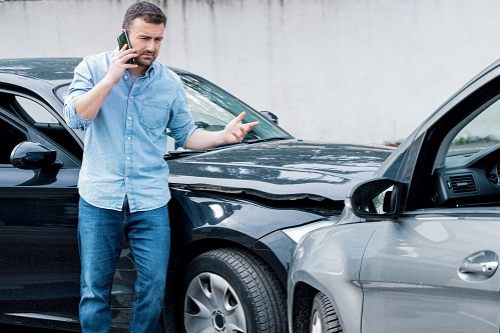- What is a state minimum car insurance policy?
- How does a minimum liability-only insurance policy work?
- Why minimum coverage limits exist: Protecting everyone on the road
- State minimum car insurance requirements and cost
- Is state minimum insurance enough?
- The one state that doesn't require car insurance: New Hampshire
- How your state minimum policy works if you travel to a state with different laws
- What about minimum coverage in no-fault car insurance states?
- Minimum car insurance limits: The bottom line
- FAQ: State minimum car insurance requirements
What is a state minimum car insurance policy?
State minimum car insurance is the minimum amount of car insurance coverage you're required to have in your state to be on the road.
All states have financial responsibility laws that outline each driver's legal liability in the event of an accident. In every state except New Hampshire, insurance is required to meet that responsibility.
Each state determines what's included in a minimum coverage policy and how much you need to carry. Depending on where you live, state minimum coverage may include:
- Liability insurance
- Personal injury protection
- Medical payments
- Uninsured/underinsured motorist coverage
How does a minimum liability-only insurance policy work?
Liability car insurance coverage is typically written out as three numbers. The most common limits are 25/50/25, although some states are higher or lower. Those numbers mean that the minimum car insurance requirement is:
- $25,000 for injuries to one person in an accident
- $50,000 for all injuries in an accident
- $25,000 for property damage in one accident
These are the maximums that the insurance company will pay out in any single accident.
Remember that liability insurance doesn't pay for damages to your own car. It also doesn't pay for your own medical expenses if you're injured in an accident. Liability insuranceLiability insurance covers sums that an insured becomes legally obligated to pay because of bodily injuries or property damage, or financial losses caused to other people. covers only damage you cause to other vehicles and property, as well as medical expenses for those you injure.
Why minimum coverage limits exist: Protecting everyone on the road
Minimum insurance requirements ensure that every driver on the road is financially responsible for their actions. It protects everyone by ensuring there are financial resources to cover the injuries and damage resulting from car accidents.
Most people can't afford to pay out of pocket to repair someone else's car if they hit it, or to cover the medical bills if someone is injured. The requirement for minimum car insurance protects both the at-fault driver from financial difficulty and lawsuits and the injured party from being stuck with the bill if an at-fault driver won't pay.
State minimum car insurance requirements and cost
State minimum car insurance requirements vary by state. Some states require only liability insurance, while others also require uninsured/underinsured motorist coverage, personal injury protectionPersonal injury protection (PIP) pays for your medical, hospital and funeral expenses resulting from a car accident, regardless of who's at fault. or MedPay.
Below, we’ve outlined the car insurance minimums in each state.
| State | State minimum limit | Minimum coverage average rate | Additional required coverage |
|---|---|---|---|
| Alaska | 50/100/25 | $415 | |
| Alabama | 25/50/25 | $514 | |
| Arkansas | 25/50/25 | $503 | |
| Arizona | 25/50/15 | $662 | |
| California | 30/60/15 | $751 | |
| Colorado | 25/50/15 | $547 | |
| Connecticut | 25/50/25 | $1,039 | UIMBI and UMBI |
| Washington, D.C. | 25/50/10 | $896 | UMBI and UMPD |
| Delaware | 25/50/10 | $1,277 | |
| Florida* | 0/0/10 | $1,208 | PIP |
| Georgia | 25/50/25 | $780 | |
| Hawaii | 20/40/10 | $425 | PIP |
| Iowa | 20/40/15 | $330 | |
| Idaho | 25/50/15 | $423 | |
| Illinois | 25/50/20 | $462 | UMBI |
| Indiana | 25/50/25 | $445 | |
| Kansas | 25/50/25 | $520 | UMBI and PIP |
| Kentucky | 25/50/25 | $708 | PIP |
| Louisiana | 15/30/25 | $993 | |
| Massachusetts | 20/40/5 | $621 | UIMBI, UMBI, PIP and Mandatory BI |
| Maryland | 30/60/15 | $815 | UMBI, UMPD and PIP |
| Maine | 50/100/25 | $377 | UMBI and Med |
| Michigan | 50/100/10 | $714 | PIP and Property Protection |
| Minnesota | 30/60/10 | $585 | UIMBI, UMBI and PIP |
| Missouri | 25/50/25 | $544 | UMBI |
| Mississippi | 25/50/25 | $510 | |
| Montana | 25/50/20 | $422 | |
| North Carolina | 50/100/50 | $476 | UMBI and UMPD |
| North Dakota | 25/50/25 | $354 | UIMBI, UMBI and PIP |
| Nebraska | 25/50/25 | $369 | UIMBI and UMBI |
| New Hampshire** | 25/50/25 | $447 | UIMBI, UMBI and Med |
| New Jersey | 25/50/25 | $1,124 | UIMPD, UMBI, UMPD and PIP |
| New Mexico | 25/50/10 | $475 | |
| Nevada | 25/50/20 | $908 | |
| New York | 25/50/10 | $1,070 | UIMBI, UMBI and PIP |
| Ohio | 25/50/25 | $390 | |
| Oklahoma | 25/50/25 | $452 | |
| Oregon | 25/50/20 | $715 | UMBI and PIP |
| Pennsylvania | 15/30/5 | $421 | PIP |
| Rhode Island | 25/50/25 | $761 | |
| South Carolina | 25/50/25 | $682 | UMBI and UMPD |
| South Dakota | 25/50/25 | $382 | UIMBI and UMBI |
| Tennessee | 25/50/25 | $515 | |
| Texas | 30/60/25 | $620 | |
| Utah | 30/65/25 | $708 | PIP |
| Virginia | 50/100/25 | $528 | UMBI and UMPD |
| Vermont | 25/50/10 | $299 | UIMBI, UMBI and UMPD |
| Washington | 25/50/10 | $490 | |
| Wisconsin | 25/50/10 | $407 | UMBI |
| West Virginia | 25/50/25 | $577 | UIMBI, UIMPD, UMBI and UMPD |
| Wyoming | 25/50/20 | $286 |
Source: Insurance Information Institute
*Florida doesn’t require bodily injury liability and is a no-fault state.
**New Hampshire doesn’t require auto insurance by law, but policies must offer at least this much coverage.
***A combined single-limit policy of $75,000 is also available.
Key to acronyms:
- UM: Uninsured motorist coverage
- UIM: Underinsured motorist coverage
- UM BI: Uninsured motorist bodily injury coverage
- UMPD: Uninsured motorist property damage coverage
- PIP: Personal injury protection
- PPI: Property protection insurance (applies only to Michigan)
- BI liability: Bodily injury liability
Is state minimum insurance enough?
State minimum requirements are often not enough to cover even minor accidents. We recommend that you carry at least $100,000 of bodily injury protection per person, $300,000 per accident and $100,000 for property damage (100/300/100).
Typically, increasing your liability limits doesn't cost much more. Consider the following, from our most recent data:
- The nationwide average cost for state minimum liability coverage is $618 a year.
- Increasing that coverage to 50/100/50 averages only $801, an increase of only $183 a year, or just under $16 a month.
- If you increase that to 100/300/100 with comprehensive and collision and a $500 deductible, that average goes up to $2,513, which is $1,895 more per year or $158 more per month.
As you can see above, in some states you can more than double your coverage by increasing your limits to 50/100/50.
The one state that doesn't require car insurance: New Hampshire
New Hampshire is the only state that doesn’t require car insurance, but there are minimum limits for those who do buy a policy, and drivers are still required to be financially responsible in an accident. Car insurance is the best way to do that.
Virginia, where car insurance was previously not required by law, required it as of July 1, 2024.
How your state minimum policy works if you travel to a state with different laws
Your auto insurance covers you in every state and even in Canada, and your limits will automatically be increased to match the requirements in the state where the accident occurred.
For example:
- Say you live in Ohio and hold the minimum amount of coverage, which is 25/50/25. This means that the minimum liability limits in this state are $25,000 for injuries to one person, $50,000 for all injuries incurred and $25,000 for property damage for one vehicle in an accident.
- If you then travel to Maine for a vacation (where the limits are 50/100/25) and are involved in an accident, your insurance company will pay up to Maine's required limits.
Some states require different types of auto insurance by law; your insurance company will also provide that coverage in an accident.
What about minimum coverage in no-fault car insurance states?
A dozen states -- including Florida, New Jersey, Kansas, New York, Minnesota and Michigan – have no-fault car insurance laws. No-fault is a system where your insurance company will pay for injuries to you and your passengers no matter who is at fault.
True no-fault states require drivers to purchase minimum levels of personal injury protection (PIP) coverage. The amount of coverage required varies by state, as does the nature of the coverage. Depending on the state, PIP coverage may reimburse the policyholder for medical and other accident-related expenses as well as lost wages.
No-fault coverage does not mean that a driver is not found at fault. A driver can still be found at fault and a claimAn insurance claim is a request you make to your insurance company for coverage after your car is damaged or you have an accident. You can file a claim online, by phone, or in writing. be placed against that person's liability coverage. The at-fault driver will also face higher insurance rates.
Minimum car insurance limits: The bottom line
No matter what coverage your state requires, you should examine your needs and buy a policy that is right for you. It may be a state minimum one if that's all your budget allows, but it's always worth shopping around to see if you can get better coverage at a lower price. If you have assets to protect and a car that you can't afford to replace, it's best to increase your limits and purchase a full coverage policy to provide greater protection.
Regardless of the coverage you choose, shopping around is always the best way to save.
FAQ: State minimum car insurance requirements
Do all states require car insurance?
All but one state; New Hampshire is the only state where car insurance isn’t required by law.
Which type of auto insurance is required by law in most states?
Liability insurance is the most commonly required coverage and is required in some form in every state where auto insurance is mandated.
Does every state have the same requirements for coverage?
No; coverage requirements vary. States have different requirements for the amount of liability coverage required and may also require additional coverages such as personal injury protection (PIP) and uninsured/underinsured motorist coverage (UM/UIM).
What happens if I don’t meet state minimum car insurance requirements?
While the penalties vary by state, they include fines, license suspension and vehicle registration suspension.



